

 |
 |
 |
 |
 |
 |
 |
 |
 |
 |
If you want to learn about the most commonly-used shooting formats, view the first three subpages referenced in the first table below!
All movies released in theatres nowadays must be in the "flat" or "scope" formats. If not, very few theatres would be able to play the movie. Although there are many shooting formats, the theatrical release prints must be either "flat" or "scope" compatible.
| Theatrical Release Format | Aspect Ratio | Film | Format | Brief Description |
| Flat | 1.85:1 | 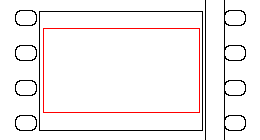 |
Flat Widescreen |
Very popular. Inefficient use of image area. Open-matte transfer of image fits televisions well. 1.66:1 in Europe.
Movie examples: |
| Scope | 2.39:1 | 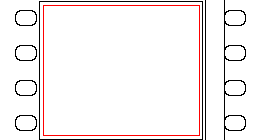 |
2:1 Anamorphic (Scope) |
Uses a 2:1 horizontal squeeze in filming, and a 2:1 horizontal unsqueeze in projection. Very efficient use of image area. Does not translate well to television (44 percent image loss).
Movie examples: |
| Scope | 2.39:1 | 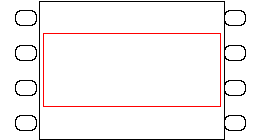 |
Super35 (Scope) |
Uses silent aperture in shooting. 2.39:1 slice extracted from source and printed in scope format on theatrical release prints, requiring the 2:1 horizontal unsqueeze in projection. Very inefficient use of image area of source. Open-matte transfer of source fits televisions well.
Movie examples: |
| Theatrical Release Format | Aspect Ratio | Film | Format | Brief Description |
| Scope | 2.39:1 |  |
Techniscope |
Poor man's scope. Runs film at half speed, using only 2 perforations per frame instead of 4. Scope theatrical release prints are made by blowing up each frame by a factor of 2 in the vertical direction only, which fits the "scope" release format perfectly. Note that this format used the image area very efficiently, but only has half the vertical resolution of films shot in anamorphic scope format. Movie examples: THX-1138, American Graffiti, underwater scenes in Titanic. Subpage not implemented yet: coming soon. |
| Theatrical Release Format | Aspect Ratio | Film | Format | Brief Description |
| Flat | 1.85:1 | No diagram yet | 16mm |
In shooting, very similar to 35mm flat widescreen format, except on a smaller scale. A 1.85:1 area is extracted from the 1.33:1 image area of the 16mm film and is blown up to 35mm, resulting in a hard-matted 35mm flat widescreen print. Movies shot this way look very grainy. Movie examples: Clerks |
| Flat | 1.85:1 | No diagram yet | Super16 |
In shooting, the soundtrack area of the 16mm film is used for image, resulting in a 0.493" by 0.292" camera aperture (1.69:1 aspect ratio). This source image is blown up to 35mm and printed in the flat format, resulting in a hard-matted 1.69:1 flat print, which is run at 1.85:1 in theatres, of course. Movies shot this way look very grainy. Movie examples: Chasing Amy, Leaving Las Vegas |
| Theatrical Release Format | Aspect Ratio | Film | Format | Brief Description |
| Silent | 1.33:1 | 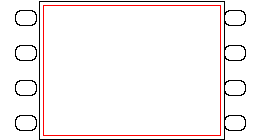 |
Silent |
No soundtrack, image only. Most efficient use of image area possible. Not properly playable in most theatres. |
| N/A | 1.17:1 |  |
Early Sound |
Soundtrack was added, which took away part of the width of the image, which changed the aspect ratio. Could be played in most theatres by removing the anamorphic attachment from the scope lens, although the masking would not likely be adjustable to the correct image size. |
| Academy | 1.37:1 | 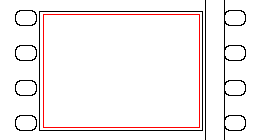 |
Academy |
After the aspect ratio of sound film was adjusted to be similar to silent film, this was the standard film format until the widescreen era, which began in the early 1950s. Could be played in most theatres by removing the anamorphic attachment from the scope lens, although the maskign would not likely be adjustable to the correct image ratio, and the image would not be tall enough to fill the screen.
Movie examples: |
| Theatrical Release Format | Aspect Ratio | Film | Format | Brief Description |
| Flat | 1.66:1 1.85:1 |
 |
Vistavision |
35mm film running horizontally, 8 perforations per frame. Theatrical release prints were made by reducing the source image to fit the standard flat widescreen 35mm format. The higher resolution of the source helped the appearance of the images, even though the release prints had the same amount of used image area as normal flat films. Movie examples: White Christmas (1954, first Vistavision appearance), The Ten Commandments, To Catch a Thief Subpage not yet implemented: coming soon. |
| Scope | 2.35:1 |  |
Technirama |
35mm film running horizontally, 8 perforations per frame, with a 1.5:1 anamorphic squeeze during filming (2.25:1 aspect ratio). Theatrical release prints were made by slightly cropping the source image to 2.35:1 and printing it onto the 35mm release prints in scope format, requiring the 2:1 unsqueeze in projection. The higher resolution of the source helped the appearance of the images, even though the release prints had the same amount of used image area as normal scope films. Movie examples: Les Miserables (1957), The Pink Panther Subpage not yet implemented: coming soon. |